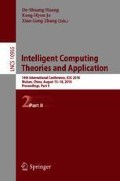Abstract
Bat algorithm (BA) is a kind of heuristic algorithm imitating the echolocation behavior of bats. In consideration of BA shortcomings such as that it could easily fall into traps like local optimum, low accuracy and premature convergence, a new algorithm is proposed by combining steepest descent (SD) algorithm and bat algorithm based on their respective advantages and disadvantages so as to achieve the goal of solving systems of non-linear equations effectively. The results of simulation experiments show that this proposed algorithm (SD-BA) can help improve the accuracy of problem solving and make the optimization results more accurate, and therefore, it is a very efficient and reliable algorithm for solving systems of non-linear equations.
Access this chapter
Tax calculation will be finalised at checkout
Purchases are for personal use only
References
Yang, X.S.: Nature-Inspired Meta Heuristic Algorithms. Luniver Press, Bristol (2010)
Xiao, H.H., Duan, Y.M.: Research and application of improved bat algorithm based on DE algorithm. Comput. Simul. 31(1), 272–301 (2014)
Yang, X.S.: Bat algorithm for multi-objective optimization. Int. J. Bio-Inspir. Comput. 3(5), 267–274 (2011)
Yang, X.S., Hossein, G.A.: Bat algorithm: a novel approach for global engineering optimization. Eng. Comput. 29(5), 464–483 (2012)
Komarasarmy, G., Wahi, A.: An optimized k-means clustering technique using bat algorithm. Eur. J. Sci. Res. 84(2), 263–273 (2012)
Sheng, X.H., Ye, C.M.: Application of bat algorithm to permutation flow-shop scheduling problem. Ind. Eng. J. 16(1), 119–124 (2013)
Huang, G.Q., Zhao, W.J., Lu, Q.Q.: Bat algorithm with global convergence for solving large-scale optimization problem. Appl. Res. Comput. 30(5), 1323–1328 (2013)
Wang, X., Wang, W., Wang, Y.: An adaptive bat algorithm. In: Huang, D.-S., Jo, K.-H., Zhou, Y.-Q., Han, K. (eds.) ICIC 2013. LNCS (LNAI), vol. 7996, pp. 216–223. Springer, Heidelberg (2013). https://doi.org/10.1007/978-3-642-39482-9_25
Pan, T.S., Dao, T.K., Chu, S.C.: Hybrid particle swarm optimization with bat algorithm. Genet. Evol. Comput. 329, 37–47 (2015)
Luo, Q.F., Zhou, Y.Q., Xie, J., Ma, M.Z., Li, L.L.: Discrete bat algorithm for optimal problem of permutation flow shop scheduling. Sci. World J. 2014, 15 (2014)
Yang, N.C., Le, M.D.: Optimal design of passive power filters based on multi-objective bat algorithm and pare to front. Appl. Soft Comput. 35, 257–266 (2015)
Yuvaraj, T., Ravi, K., Devabalaji, K.: DSTATCOM allocation in distribution networks considering load variations using bat algorithm. Ain Shams Eng. J. 8(3), 391–403 (2017)
Sun, W., Liu, M., Liang, Y.: Wind speed forecasting based on FEEMD and LSSVM optimized by the bat algorithm. Energies 8(7), 6585–6607 (2015)
Zhang, X.W., Xing, Z.D., Dong, J.M.: A hybrid genetic algorithm to seeking the optimum solution of a class of unconstrained optimization. J. Northwest Univ. (Nat. Sci. Edit.) 35(2), 130–132 (2005)
Haario, H., Saksman, E.: Simulated annealing process in general state space. Adv. Appl. Probab. 23(4), 866–893 (1991)
Zhao, X.P.: Convergence on the steeped decent method using difference quotient. J. East China Inst. Chem. Technol. 18(6), 807–812 (1992)
Parlos, A.G., Fernandez, B., Atiya, A.F., Muthusami, J., Tsai, W.K.: An accelerated learning algorithm for multilayer perception networks. IEEE Trans. Neural Netw. 5(3), 493–497 (1994)
Nguyen, N., Milanfar, P., Golub, G.: A computationally efficient super resolution image reconstruction algorithm. IEEE Trans. Image Process. 10(4), 573–583 (2001)
Li, Y., Santosa, F.: A computational algorithm for minimizing total variation in image restoration. IEEE Trans. Image Process. 5(6), 987–995 (1996)
Murota, K., Tanaka, K.: A steepest descent algorithm for M-convex functions on jump systems. IEICE Trans. Fundam. Electron. Commun. Comput. Sci. E89A(5), 1160–1165 (2006)
Burges, C., Shaked, T., Renshaw, E., Lazier, A., Deeds, M., Hamilton, N., Hullender, G.: Learning to rank using gradient descent. In: Proceeding of the 22nd International Conference on Machine Learning, pp. 89–96 (2005)
Yang, X.S.: A new meta-heuristic bat-inspired algorithm. In: González, J.R., Pelta, D.A., Cruz, C., Terrazas, G., Krasnogor, N. (eds.) Nature Inspired Cooperative Strategies for Optimization, vol. 284, pp. 65–74. Springer, Heidelberg (2010). https://doi.org/10.1007/978-3-642-12538-6_6
Acknowledgements
The research was partially funded by the science and technology project of Guizhou ([2017]1207), the training program of high level innovative talents of Guizhou ([2017]3), the Guizhou province natural science foundation in China (KY[2016]018), the Science and Technology Research Foundation of Hunan Province (13C333).
Author information
Authors and Affiliations
Corresponding author
Editor information
Editors and Affiliations
Rights and permissions
Copyright information
© 2018 Springer International Publishing AG, part of Springer Nature
About this paper
Cite this paper
Ge, G., Song, J., Wang, J., Ouyang, A. (2018). Steepest Descent Bat Algorithm for Solving Systems of Non-linear Equations. In: Huang, DS., Jo, KH., Zhang, XL. (eds) Intelligent Computing Theories and Application. ICIC 2018. Lecture Notes in Computer Science(), vol 10955. Springer, Cham. https://doi.org/10.1007/978-3-319-95933-7_87
Download citation
DOI: https://doi.org/10.1007/978-3-319-95933-7_87
Published:
Publisher Name: Springer, Cham
Print ISBN: 978-3-319-95932-0
Online ISBN: 978-3-319-95933-7
eBook Packages: Computer ScienceComputer Science (R0)

